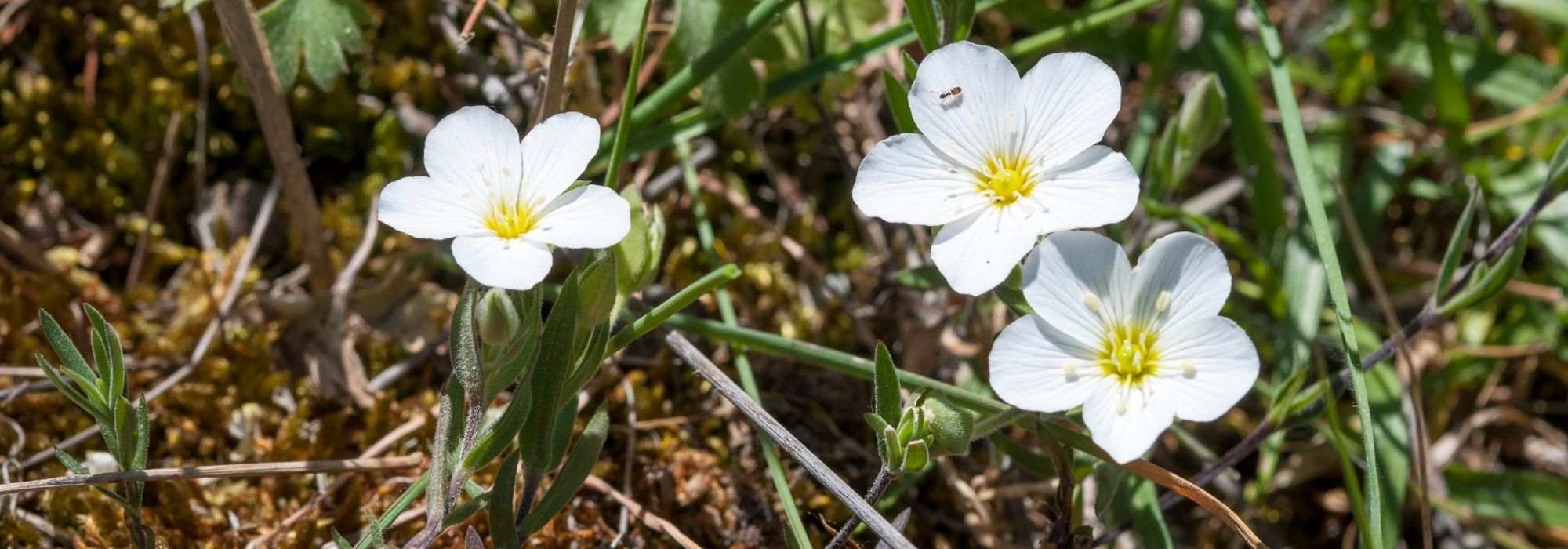
Arenaria, sandwort: planting, growing and care
Contents
Arenaria in a nutshell
- The Arenaria, or Sandwort, is a hardy evergreen perennial that requires little care
- It prefers well-drained, sandy, and cool soil
- It thrives in a bright but not scorching position
- Hardy and low-maintenance, it forms very low green cushions
- Its long white flowering occurs from spring to summer
- An alpine perennial, it enhances rockeries, border beds, and containers
The word from our expert
The Arenaria, or Sandwort, is one of those hardy alpine perennials that thrive at altitude. A low-maintenance plant, it forms flat cushions of a more or less greyish green, which are covered in small white flowers over a long period, from spring to summer. Evergreen, it remains attractive throughout the year, asserting its presence when many other plants are dormant. Ideal for rockeries, it tolerates almost all soils that are not too calcareous, as long as they are perfectly drained in winter and ensure a certain freshness in the season. Avoiding summer drought and root competition, a clear and bright but not scorching exposure is preferred. It can thus grow in full sun or partial shade depending on the region where it is cultivated. It is an excellent choice for creating rockeries, edging a flowerbed, or softening a paving. Growing it in pots also yields good results.
Description and Botany
Botanical data
- Latin name Arenaria
- Family Caryophyllaceae
- Common name Arenaria, Sabline
- Flowering spring / summer
- Height 10 to 15 cm x 40 cm
- Sun exposure sun (non-burning), partial shade
- Soil type well-drained, cool, neutral
- Hardiness good (-15°C)
The genus Arenaria belongs to the Caryophyllaceae family, alongside the Carnation, Gypsophila, Silene, and Soapwort. Primarily native to the Northern Hemisphere, it can be found globally, in both cold mountainous regions and more temperate areas. The Arenaria, or Sabline, derives its vernacular name from its preference for well-draining sandy soils. Etymologically, the word ‘Arena’ also refers to sand. The genus comprises around 160 species of perennial and annual plants, but only a few are used for ornamental purposes. Among them, the most common are Arenaria montana (Mountain Sabline), Arenaria pungens (Silver Sagine), Arenaria balearica (Balearic Sabline), and Arenaria tetraquetra (syn. Arenaria pyrenaica, or Four-ranked Sabline).
This perennial can sometimes appear shrubby with age and under certain growing conditions, but it predominantly remains a spreading groundcover plant that forms low cushions. Growing to a height of 10 to 15 centimetres, the stump features fine rooting stems that, like those of the Fragrant Violet, creep along the soil surface. The Sabline thus spreads over approximately forty centimetres.
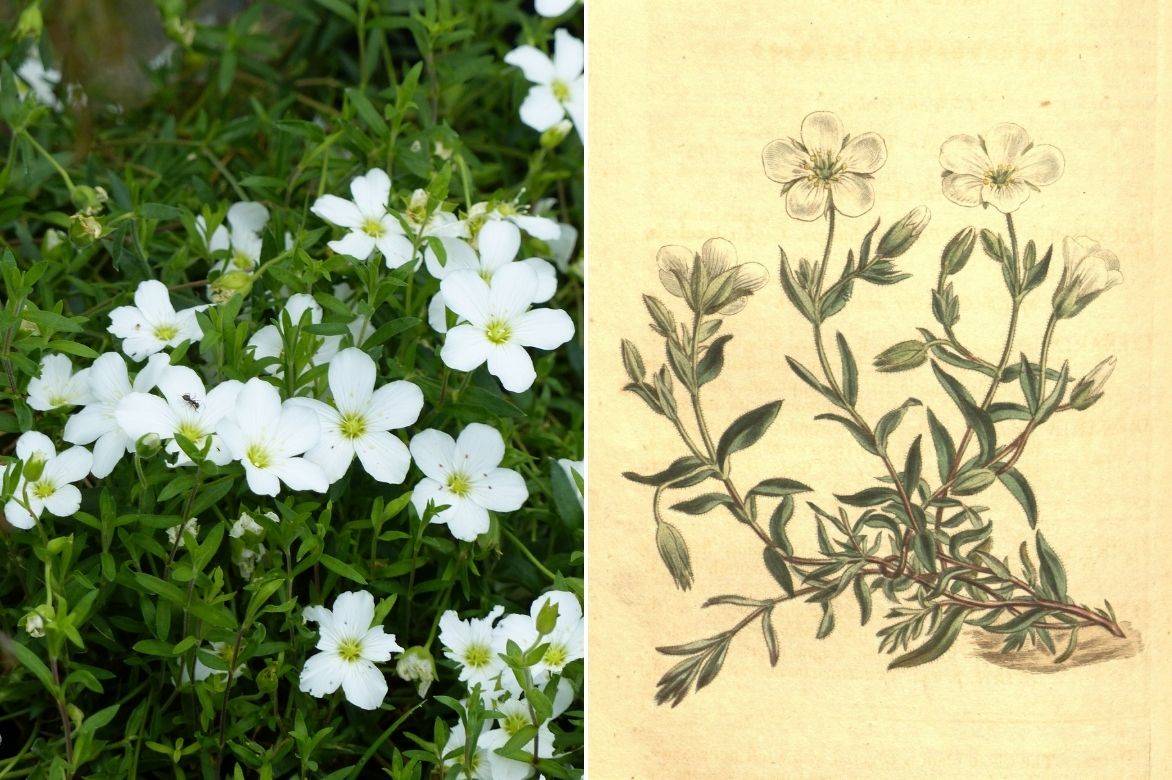
Arenaria montana – Botanical illustration (source Biodiversity Heritage Library – Flickr)
The persistent foliage consists of tiny, slightly villous leaves, green to grey-green, which can sometimes resemble moss. In Arenaria tetraquetra, the leaves overlap curiously, giving it a false resemblance to heather. From this dense cushion, small flowers with five petals emerge from spring to summer, appearing solitary or in clusters atop short upright stems, and they are most often white with a yellow-green eye. Measuring a few millimetres in Arenaria balearica, they can reach up to 2.5 centimetres for the Mountain Sabline, which, proportionally, displays the widest corollas. The flowering period is long and can extend over a month. Some species bear purple flowers, such as the Red Sabline (Arenaria rubra), an annual used in herbalism for its diuretic properties; nicknamed ‘stonebreaker’, it is indeed used in decoction or infusion to dissolve kidney stones. Once the flowers have faded, the Arenaria produces tiny capsule fruits.

The foliage of Arenaria varies greatly by species: Arenaria tetraquetra ssp granatensis (photo Ghislain118), Arenaria montana (photo Mtiffany71 – Wikimedia) and Arenaria pungens (photo Römert – Wikimedia)
Extremely floriferous and hardy (-15°C and beyond), Arenaria is a perennial very easy to grow and disease-free. Its origins make it suitable for a sunny to partially shaded location, in any cool but well-drained soil. It is thus perfect for enhancing a cool rockery, greening a not-too-dry wall, adorning the front of borders, or decorating the gaps between paving stones and slabs. It is also a good candidate for pot displays or flowering troughs. However, be cautious, as its chances of survival are low in overly dry conditions.
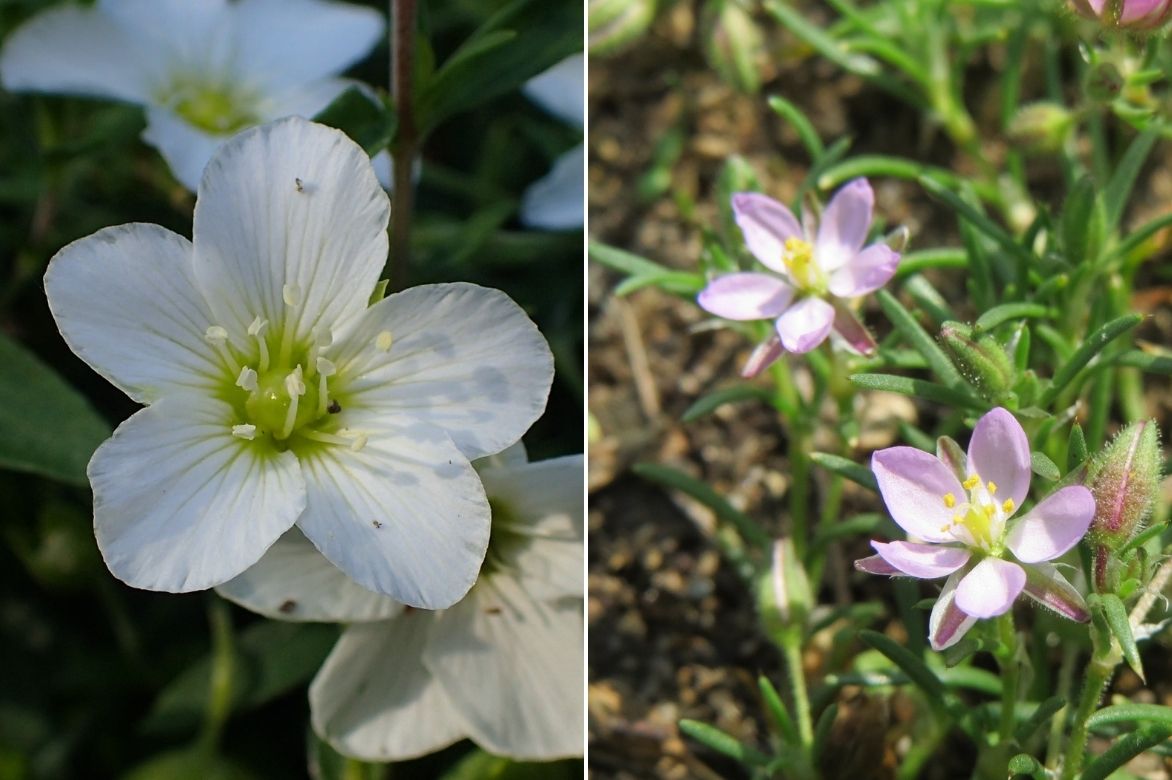
Arenaria montana (photo Kenraiz – Wikimedia) and Arenaria rubra (photo AnRo0002 – Wikimedia)
The different species
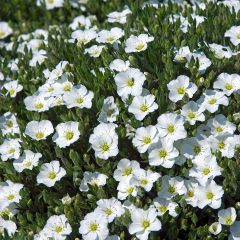
Arenaria montana
- Flowering time June to August
- Height at maturity 15 cm
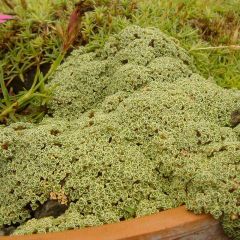
Arenaria tetraquetra subsp. amabilis subsp. Amabilis
- Flowering time June, July
- Height at maturity 10 cm
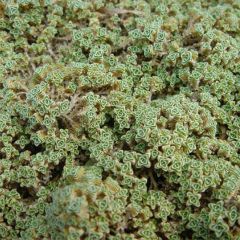
Arenaria tetraquetra subsp. granatensis subsp. granatensis
- Flowering time May
- Height at maturity 10 cm
Discover other Arenaria
View all →Available in 1 sizes
Available in 1 sizes
Available in 2 sizes
Planting
Where to Plant the Sandwort
Arenaria is a mountain plant. It is hardy and suitable for many gardens. As it does not tolerate very dry and hot conditions well, ensure it has a bright location. In the North, it can be placed in a sunny spot; further South, partial shade is more suitable. In all cases, soil that retains good moisture during the season but does not allow water to stagnate is key to success. It accepts all types of soil that are not too rich or too calcareous.
The Sandwort is one of those alpine perennials that thrive in cool rockeries. It can also adorn a low wall, decorate a border of flower beds, or weave between the paving stones of a path to soften its mineral aspect. For gardeners with only a balcony or terrace, pot cultivation yields excellent results. Allow it enough space to develop well, avoiding excessive root competition with potential neighbours.
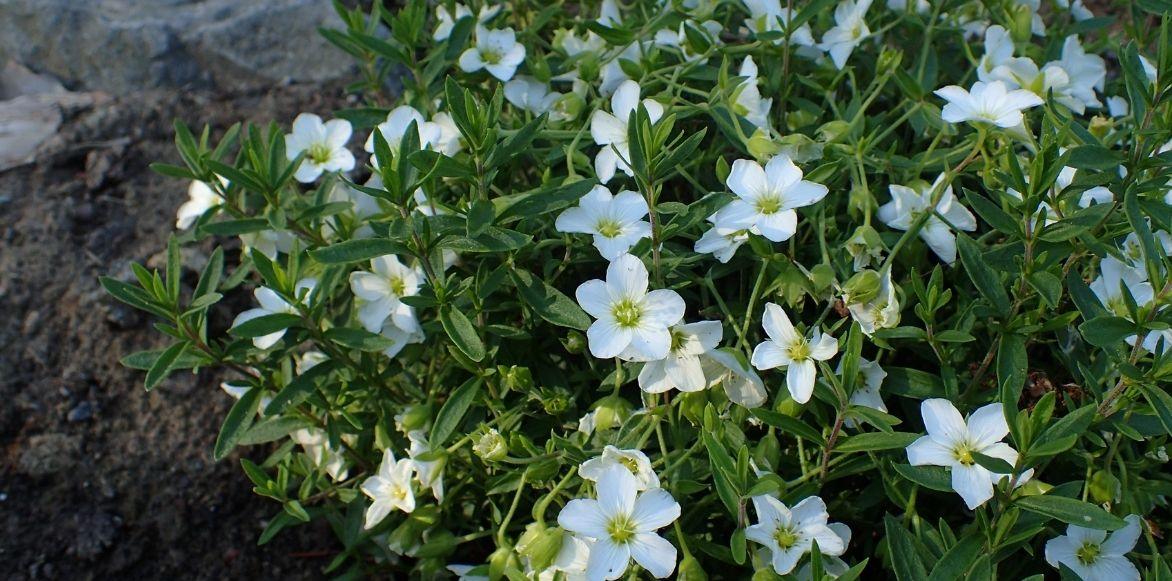
Arenaria montana – Szeged Botanical Garden (photo Kenraiz – Wikimedia)
When to Plant the Sandwort?
In regions with cold, damp winters, prefer early spring for planting your Sandwort. In milder climates, you can also consider planting it in the early autumn.
How to Plant the Sandwort?
- Dig a hole 2 to 3 times the size of the root ball and loosen the soil.
- In heavy soil, improve drainage by adding coarse sand, gravel, or pumice.
- After thoroughly soaking the root ball by allowing it to absorb water in a bucket while you prepare the soil, place your plant in the desired location.
- Fill in with the remaining substrate and lightly firm it down.
- Water generously to ensure good contact between the soil and the roots.
- Mulch, preferably with a mineral mulch (gravel, sand, etc.), to prevent water from stagnating at the collar (the junction between the aerial and underground parts).
- Remember to keep the soil moist but not waterlogged during the first few months. Adjust your interventions according to climatic conditions.
In pots, place a drainage layer at the bottom of the container (gravel, clay balls, etc.), and use a light, well-draining substrate that is not too rich, such as potting soil mixed with coarse sand.
Read also
Alpine perennial plantsMaintenance
The Arenaria is a perennial that requires very little maintenance, especially if you have planted it in well-draining, cool soil, and in a not too arid situation. Occasional watering may be necessary if rainfall is insufficient, but be careful not to drown your plant. Wait until the substrate dries slightly before intervening. An excess of water can indeed cause the roots to rot.
Once the flowering is over, and although pruning is optional, you can cut the plant back quite severely to maintain a dense and compact habit. It will then produce fresh foliage, which remains decorative for the rest of the year.
Multiplication
The simplest method to multiply Arenaria is clump division, which should be done in early spring.
- Using a spade, lift the plant from the ground, ensuring to retain as many roots and as much soil as possible.
- Divide your plant into several sections, either by cutting it with your spade or using a sharp knife.
- Replant immediately the sections obtained in the chosen location.
- Water and mulch.
Associate Arenaria with the garden
Hardy alpine perennial, Arenaria allows for the creation of low, bright carpets that beautifully punctuate a rockery.
Pair it with other perennials for well-drained soil, such as Saxifrages, Aubriètes, Alysses, Arabis, or even subulate Sagines. Columbines add beautiful, natural colour accents that rhythmically enhance the bed, just like the Mountain Cornflower, with its very dark, almost black corollas, ensuring striking contrasts. The blue of the Asclepias Gentian adds depth, though it is somewhat more demanding in cultivation. The Edelweiss transports you to the steep slopes of the Alps, distinguished by its originality and rarity.
In late winter and early spring, many early-flowering bulbs (Crocus, Chionodoxa, Cyclamen coum, Daffodils, and botanical Tulips…) awaken the scene with cheerfulness.
The Arenaria can also create a setting for taller, upright perennials, such as the Caucasian Speedwell or the tall White Willowherb.
It can also form a carpet against which the structural silhouettes of bushes stand out. Among the rockery conifers, the Japanese Pine, with its upright silhouette, or the Mughus Mountain Pine, with a more compact habit, make excellent candidates. You can also consider deciduous plants such as Abelias and Ceanothus (in not too cold climates), Berberis, Heathers, or certain Cotoneasters.
Finally, to bring grace and movement, focus on grasses. Deciduous or evergreen, they undulate in the wind and energise your compositions.
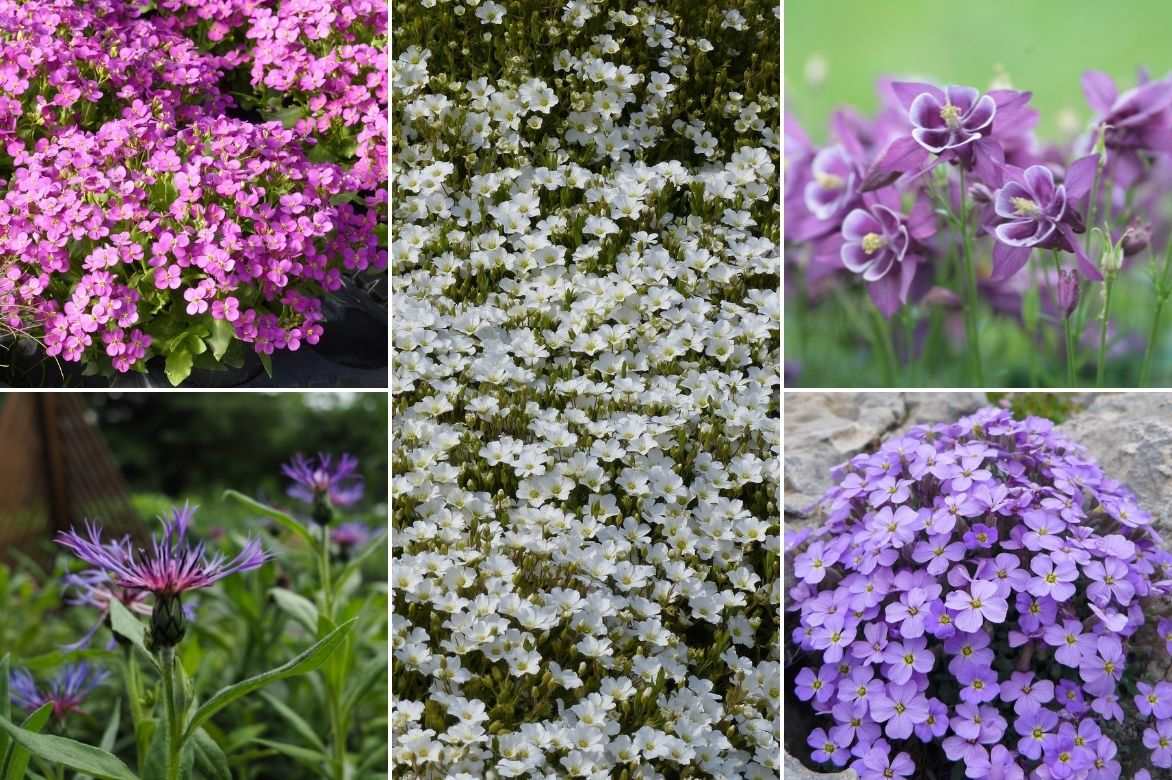
Arenaria montana, alongside ground-cover plants like Arabis caucasica ‘Roselite’ and Aubrieta x cultorum ‘Novalis Blue’, as well as upright perennials like Columbines and Mountain Centaury
Useful resources
–> Our different species and varieties of Sandwort.
–> Discover the world of alpine perennials!
–> Rockery conifers, structural and evergreen bushes.
- Subscribe!
- Contents


































Comments